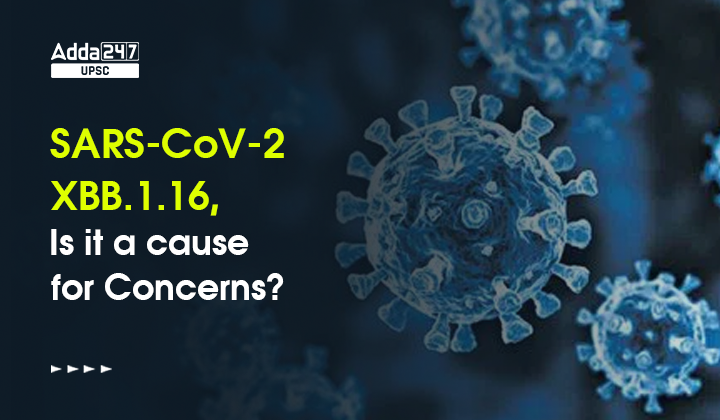Table of Contents
SARS-CoV-2 XBB.1.16: The XBB.1.16 is a recombinant lineage of the SARS Covid virus. It is a descendent of the XBB lineage. SARS-CoV-2 XBB.1.16 is also important for UPSC Prelims 2023 and UPSC Mains Exam (GS Paper 3- Science and Technology and various related developments; Disasters and Disaster Management).
SARS-CoV-2 XBB.1.16 in News
Throughout the course of the last three years and multiple outbreaks of COVID-19, the SARS-CoV-2 virus has been undergoing genetic changes, leading to the emergence of new variants or strains. In this context, The XBB.1.16 is a recombinant lineage of the SARS Covid virus that has been circulating predominantly in India.
COVID-19 Recombinants
When a virus is co-infected with multiple lineages, there is a possibility that the resulting recombinations between genomes can create chimeric genomes, known as recombinants. Although most recombinations do not produce viable viruses, in rare cases, recombination can lead to the emergence of a new lineage of the virus with enhanced functional capabilities.
Recombinant Lineages of SARS-CoV-2
During the COVID-19 pandemic, several recombinant lineages of SARS-CoV-2 have emerged, including two Variants Under Monitoring (VUM) designated by the World Health Organization. These variants are-
- XBB, which is a recombinant of Omicron sublineages BA.2.10.1 and BA.2.75, and
- XBF, which is a recombinant of Omicron sublineages BA.5.2.3 and BA.2.75.3.
The WHO has also designated XBB.1.5, a sublineage of XBB that was first detected in New York City in October 2022, as a Variant of Interest (VOI).
What is SARS-CoV-2 XBB.1.16 lineage?
The XBB.1.16 lineage of SARS-CoV-2 was first identified in India and is a recombinant lineage that evolved from the XBB lineage.
- Spread: It has mainly been circulating in India, but its genomes have also been found in at least 14 other countries worldwide, with many of them linked to international travel from India.
- Mutation: The XBB.1.16 lineage shares several mutations with the XBB.1.5 Variant of Interest (VOI), but it also has additional key mutations, such as E180V and T478R in the Spike protein and I5T in ORF9b.
- In comparison, the XBB.1.5 has the mutation T478K in Spike, which is associated with immune escape.
- T478R, found in the XBB.1.16 lineage, is also associated with immune evasion.
- The ORF9b I5T mutation, present in both XBB.1.16 and XBB.1.9 lineages, is believed to give the virus a growth advantage.
- Preliminary data suggests that XBB.1.16 has a higher growth advantage than currently circulating SARS-CoV-2 lineages, including XBB.1.5.
Associated Concerns with SARS-CoV-2 XBB.1.16 lineage
India is currently experiencing an increase in both seasonal influenza H3N2 and COVID-19 cases in March, despite low testing numbers.
- The number of active COVID-19 cases in India has surpassed 6,000, and the fast-spreading XBB.1.16 lineage is believed to be responsible for the recent spike in cases.
- Although genomic surveillance data in India is limited, XBB.1.16 has accounted for over 30% of sequenced genomes in March 2023, with its proportion increasing in recent weeks.
- Telangana, Karnataka, Gujarat, and Maharashtra have reported the highest number of XBB.1.16 cases, but this may be biased as not all states sequence their samples.
- Preliminary data suggests that XBB.1.16 infections do not differ in clinical severity from other Omicron lineages, but its higher growth advantage and immune escape may increase the risk of reinfection compared to other circulating Omicron lineages.
Conclusion
The government should focus on protecting vulnerable populations through established measures which could significantly reduce the rise in infections in the country.
SARS-CoV-2 XBB.1.16 FAQs
Q. What is SARS-CoV-2 XBB.1.16?
Ans. SARS-CoV-2 XBB.1.16 is a recombinant lineage of the SARS-CoV-2 virus that was first detected in India. It is a descendant of the XBB lineage and has been found to have a higher growth advantage and potential for immune escape than other Omicron lineages.
Q. What are the symptoms of XBB.1.16?
Ans. There is currently no evidence to suggest that infections with XBB.1.16 differ in clinical severity from those caused by other Omicron lineages. However, its higher growth advantage and potential for immune escape may increase the risk of reinfection compared to other circulating Omicron lineages.
Q. Is the current COVID-19 vaccine effective against XBB.1.16?
Ans. There is currently limited information on the effectiveness of COVID-19 vaccines against XBB.1.16. However, it is believed that the vaccines provide some protection against the variant, and getting vaccinated is still strongly recommended to reduce the severity of illness and prevent hospitalization.
Q. How is XBB.1.16 detected?
Ans. XBB.1.16 is detected through genomic sequencing of positive COVID-19 samples. However, not all positive samples are sequenced, so the actual number of cases may be higher than what is reported.
Q. Where has XBB.1.16 been detected?
Ans. XBB.1.16 has been detected in at least 14 countries around the world, including India, the United States, Singapore, and several European countries. However, due to limited genomic surveillance, its actual prevalence may be higher than what is currently known.
India’s Health Ministry Wins Porter Prize 2023 For COVID-19 Management



 TSPSC Group 1 Question Paper 2024, Downl...
TSPSC Group 1 Question Paper 2024, Downl...
 TSPSC Group 1 Answer key 2024 Out, Downl...
TSPSC Group 1 Answer key 2024 Out, Downl...
 UPSC Prelims 2024 Question Paper, Downlo...
UPSC Prelims 2024 Question Paper, Downlo...





